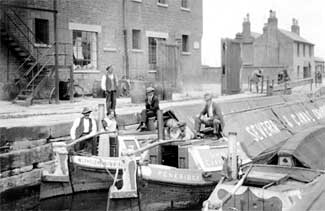 Narrow
Canal Boats Narrow
Canal Boats
The boats
were about 70ft long and 7ft wide to suit the locks of the midland
canals, and each had a small cabin at the stern for the crew to
live in while on a trip. Some boats were worked by two men, but
in many cases the master took his wife and young family as crew
or maybe just a teenage son. Each boat could carry up to 30 tons
of cargo which was usually covered by canvas cloths.
Leaving Gloucester
Boats
leaving Gloucester commonly carried grain, timber or general cargoes,
either loaded from the local warehouses and timber yards or trans-shipped
from ships or barges in the docks. Early in the morning, loaded
boats were man-handled through the lock on to the River Severn where
a steam tug was waiting to tow them 'up country'. Some boats loaded
hay from riverside meadows, and these joined the tow on the way
up the river.
Going Up the River
There
could be half-a-dozen or more boats in one or sometimes two lines
behind the tug, and progress could be slow if the boats were loaded
heavily or the river current was strong. Usual practice was to steer
close to the inside of the river bends to avoid the stronger current
around the outside. Most boats left the river at Worcester to join
the Worcester & Birmingham Canal, although some continued up
to the entrance to the Staffordshire & Worcestershire Canal
at Stourport.
Worcester to Tardebigge
At
Worcester, the crew collected a horse from the stables and set off
on the long treck to Birmingham. Generally, one member of the crew
had to walk with the horse to encourage it to keep going. If the
crew comprised a husband and wife, they were likely to take it in
turns to walk and steer, but if a child was on board, he (or she)
was expected to do most of the walking! The routine for opening
and closing gates and paddles when working through each of the 58
locks on the route was very well established. This routine was particularly
important when climbing the famous Tardebigge flight, comprising
30 locks in two miles, and it was greatly helped by having an experienced
and good natured horse.
 Tunnels on the Summit
Level Tunnels on the Summit
Level
At the top of the Tardebigge
flight is the long summit level which passes through three tunnels
on the way to Birmingham. The boats were towed through the tunnels
by tugs, and one member of each crew had to walk the horse over
the top of the hill, usually a task for a junior member of the family.
The horse towed again for the final stretch into Birmingham, and
as this ran close to a noisy railway line, special care was needed
to avoid a frightened horse slipping into the canal.
Birmingham
Most cargoes
were discharged at the numerous canalside wharfs near the centre
of Birmingham, but some were taken on further to places like Wolverhampton
and Wallsall. Many boats then went to collieries in South Staffordshire
or Cannock Chase to load coal, while others picked up iron or manufactured
goods or called in at Stoke Prior on the way home to load salt.
Returning to Gloucester
The
return to Gloucester involved passing through the tunnels, working
down the locks and getting a tow down the river. While under tow,
it was usual for each crew to clean their boat's cabin and polish
the brass ready for the next trip. The round trip commonly took
10 to 15 days, and on arrival at Gloucester, the crew returned to
their homes until the next time they went 'up country'.
Photos: The Waterways Trust BW Archive and John Jennings |